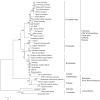Systematic analysis reveals novel insight into the molecular determinants of function, diversity and evolution of sweet taste receptors T1R2/T1R3 in primates
- PMID: 36762208
- PMCID: PMC9905694
- DOI: 10.3389/fmolb.2023.1037966
Systematic analysis reveals novel insight into the molecular determinants of function, diversity and evolution of sweet taste receptors T1R2/T1R3 in primates
Abstract
Sweet taste is a primary sensation for the preference and adaption of primates to diet, which is crucial for their survival and fitness. It is clear now that the sweet perception is mediated by a G protein-coupled receptor (GPCR)-sweet taste receptor T1R2/T1R3, and many behavioral or physiological experiments have described the diverse sweet taste sensitivities in primates. However, the structure-function relationship of T1R2s/T1R3s in primates, especially the molecular basis for their species-dependent sweet taste, has not been well understood until now. In this study, we performed a comprehensive sequence, structural and functional analysis of sweet taste receptors in primates to elucidate the molecular determinants mediating their species-dependent sweet taste recognition. Our results reveal distinct taxonomic distribution and significant characteristics (interaction, coevolution and epistasis) of specific key function-related residues, which could partly account for the previously reported behavioral results of taste perception in primates. Moreover, the prosimians Lemuriformes species, which were reported to have no sensitivity to aspartame, could be proposed to be aspartame tasters based on the present analysis. Collectively, our study provides new insights and promotes a better understanding for the diversity, function and evolution of sweet taste receptors in primates.
Keywords: coevolution; epistasis; molecular determinants; primate; species-dependent sweet taste; sweet taste receptor; taxonomic distribution.
Copyright © 2023 Wang, Liu, Cui and Liu.
Conflict of interest statement
The authors declare that the research was conducted in the absence of any commercial or financial relationships that could be construed as a potential conflict of interest.
Figures






Similar articles
-
Sweet taste receptor gene variation and aspartame taste in primates and other species.Chem Senses. 2011 Jun;36(5):453-75. doi: 10.1093/chemse/bjq145. Epub 2011 Mar 16. Chem Senses. 2011. PMID: 21414996 Free PMC article.
-
Functional characterization of the heterodimeric sweet taste receptor T1R2 and T1R3 from a New World monkey species (squirrel monkey) and its response to sweet-tasting proteins.Biochem Biophys Res Commun. 2012 Oct 19;427(2):431-7. doi: 10.1016/j.bbrc.2012.09.083. Epub 2012 Sep 20. Biochem Biophys Res Commun. 2012. PMID: 23000410 Free PMC article.
-
The sweet taste receptors in Lemuriformes respond to aspartame, a non-nutritive sweetener and critical residues mediating their taste.Biochimie. 2024 Dec;227(Pt A):129-134. doi: 10.1016/j.biochi.2024.07.005. Epub 2024 Jul 10. Biochimie. 2024. PMID: 38996999
-
The heterodimeric sweet taste receptor has multiple potential ligand binding sites.Curr Pharm Des. 2006;12(35):4591-600. doi: 10.2174/138161206779010350. Curr Pharm Des. 2006. PMID: 17168764 Review.
-
Taste information derived from T1R-expressing taste cells in mice.Biochem J. 2016 Mar 1;473(5):525-36. doi: 10.1042/BJ20151015. Biochem J. 2016. PMID: 26912569 Review.
References
-
- Cai C., Jiang H., Li L., Liu T., Song X., Liu B. (2016). Characterization of the sweet taste receptor Tas1r2 from an Old world monkey species rhesus monkey and species-dependent activation of the monomeric receptor by an intense sweetener perillartine. Plos One 11 (8), 0160079. 10.1371/journal.pone.0160079 - DOI - PMC - PubMed
-
- Dieter G., Henk V., Brouwer J. N., Dubois G. E., Göran. H. (1992). Gustatory responses in primates to the sweetener aspartame and their phylogenetic implications. Chem. Senses 17 (3), 325–335. 10.1093/chemse/17.3.325 - DOI
LinkOut - more resources
Full Text Sources

